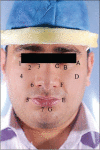Risk of Contamination of Different Areas of Dentist's Face During Dental Practices
- PMID: 23930175
- PMCID: PMC3733195
Risk of Contamination of Different Areas of Dentist's Face During Dental Practices
Abstract
Background: Dental practice presents opportunities for cross-contamination. The dentist's face is at high-risk of infection transmission. The purpose of this study was to evaluate the risk of contamination in different areas of dentist's face during dental practices.
Methods: The visible splashes of materials that accumulated on cellulose face shields during 144 prosthetics and periodontal procedures were evaluated. The splashes were detected on 14 areas (each 1 cm(2)) of the dentist's face including around nose, mouth, eyes, and zygoma by a magnifier (×2). One way Analysis of variance, Duncan and t-test were used for data analysis (α = 0.05).
Results: Contamination of different areas of dentist's face was significantly different (P < 0.05). The areas around nose and the inner corner of eyes were the most contaminated areas. Zygoma was the least contaminated area. The contaminated areas during periodontal treatments were significantly more than prosthetic treatments (P < 0.05). There was no significant difference between contamination on left and right sides of the face.
Conclusions: During dental practice, central areas of the face such as inner part of the eyes and around the nose were most contaminated areas. These parts are the important areas for transmission of infection. It is recommended to use protective means like glasses, mask, and protective shield, which have more protection field in these areas.
Keywords: Aerosols; dentists; infection control; risk.
Conflict of interest statement
Figures
References
-
- Molinari JA. Dental infection control at the year 2000. Accomplishment recognized. J Am Dent Assoc. 1999;130:1291–8. - PubMed
-
- MacCannell T, Laramie AK, Gomaa A, Perz JF. Occupational exposure of health care personnel to hepatitis B and hepatitis C: Prevention and surveillance strategies. Clin Liver Dis. 2010;14:23–36. - PubMed
-
- Leonard RH, Crawford JJ., Jr . Infectioin control. In: Heymann HO, Swift EJ Jr, Ritter AV, editors. Sturdevant's Art and Science of Operative Dentistry. 6th ed. London: Mosby; 2012. p. e98.
LinkOut - more resources
Full Text Sources
Medical

